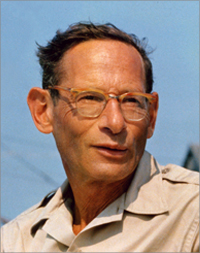Robert Serber (1909-1997) was an American physicist. He was recruited by J. Robert Oppenheimer to work on the Manhattan Project. Serber was tasked with explaining the basic principles and goals of the project to all incoming scientific staff. Moving to Los Alamos in 1943, he gave lectures to members of the Manhattan Project about the design and construction of atomic bombs known as the “Los Alamos Primer.”
Scientific Contributions
While at Los Alamos, Serber developed the first good theory of bomb disassembly hydrodynamics. He also created the code-names for all three bomb designs–“Little Boy” (uranium gun), “Thin Man” (plutonium gun), and “Fat Man” (plutonium implosion)–based on their design shapes.
After the Trinity Test in July 1945, Serber traveled to Tinian Island to assist in the construction of the bomb, as a special consultant to Project Alberta. While there, he reassured Col. Paul Tibbets, pilot of the Enola Gay, that the bomb’s blast would not harm the plane. In early September 1945, Serber was part of the first American team to enter Hiroshima and Nagasaki, assessing the bombs’ damage and collecting debris for testing on their five-week mission.
Later Years
While he later supported arms control initiatives, Serber remained convinced that the use of the atomic bombs was the correct decision and was never an outspoken critic of nuclear weapons. After the war, Serber briefly taught at Berkeley, then became a professor of physics at Columbia University in 1951.





